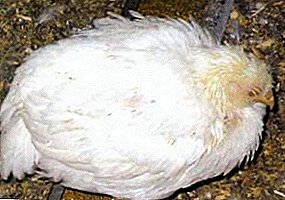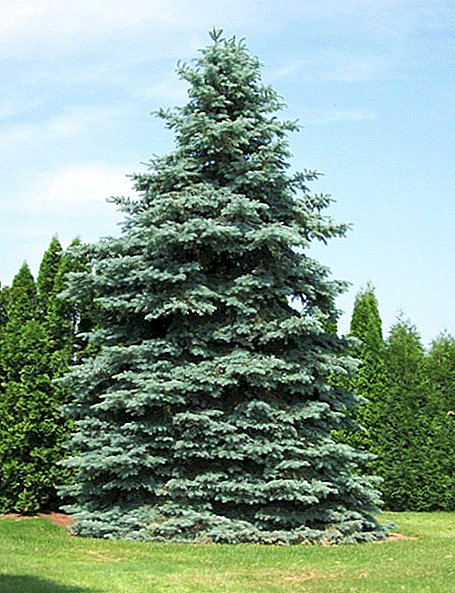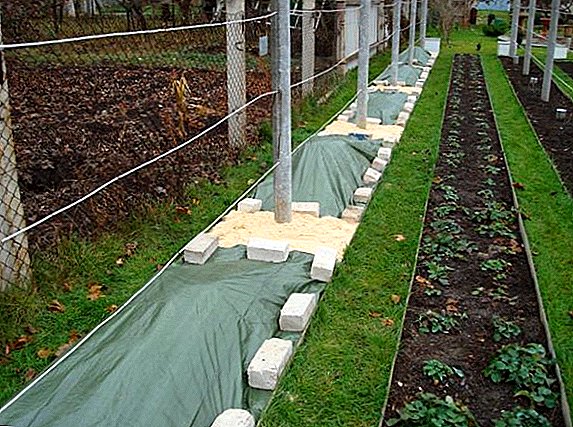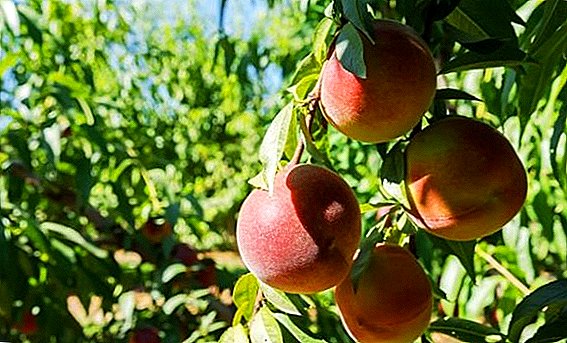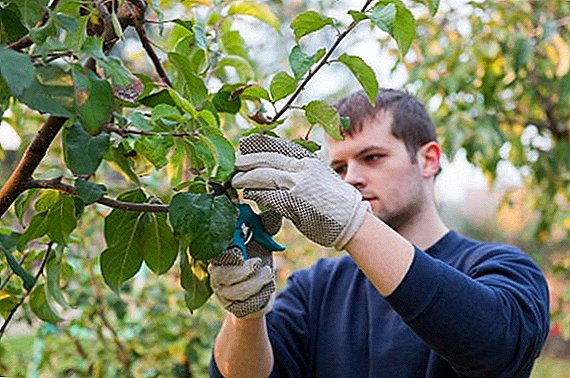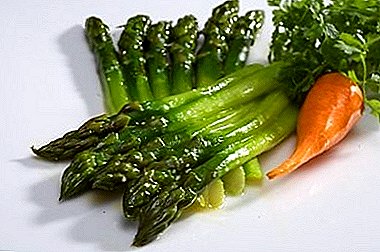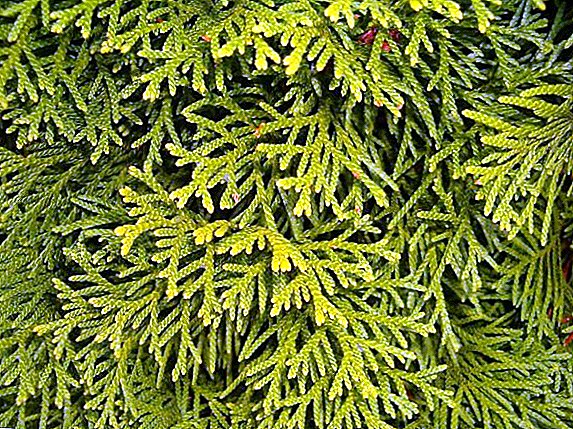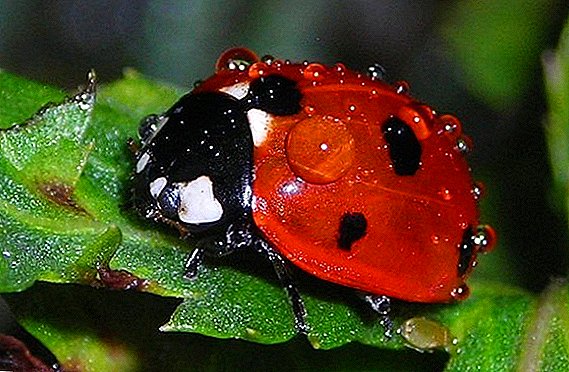 The Latin name of a ladybug sounds like "coccineus" - it means "alai". That bright bright coloring was the basis for such a name.
The Latin name of a ladybug sounds like "coccineus" - it means "alai". That bright bright coloring was the basis for such a name.
In different countries this bug is called differently, but each of the names testifies to people's love and respect for this insect.
Latin Americans call it “the cow of St. Anthony,” the Germans and Swiss call it “the bug of the Virgin Mary,” the Czechs and Slovaks call it “the sun”, and the Russians, Ukrainians and Belarusians, the “ladybird.” Let's find out what this insect brings to our gardens - benefit or harm, where it lives and what it feeds on.
Description and types
A beautiful bug with spots on the wings - all the inhabitants of the country are well aware of this insect and have seen them a dozen times in their flower gardens and gardens.
The length of the little body of the beetle can be from 5 to 8 mm. In our country, the most common ladybug with seven points on the shell ("Seven-point"). An elegant bug was nicknamed for seven dark spots on scarlet wings.  Periodically there are bugs, painted unusually: with yellowish wings and dark dots or black with white spots on the shell, and even completely without points.
Periodically there are bugs, painted unusually: with yellowish wings and dark dots or black with white spots on the shell, and even completely without points.
The spots may be more or less than seven, the color of the elytra may also be in several variants. Worldwide, there are about five thousand types of ladybirds.
A ladybug feeds on the nature of deciduous and armored aphids and spider mites, thus saving gardens and berry bushes. The insect insects of the world are formidable aphid exterminators, living on the back of leaf sheets of garden and vegetable plants.
Did you know? In many countries, there is such a direction of agricultural business as breeding ladybirds. Farmers are seriously engaged in these beneficial insects, the whole cycle of development of bugs is under strict control. In the future, insects are sold to farmers and the bill goes to thousands of individuals in each lot. Aphid hunters are sold both in the country where they were raised and sent by mail all over the world.
Life cycle features
Adult members of the family live and hibernate in the open field, hiding in the dry folded leaves or under dried blades of grass. With the onset of heat, it is time to breed the offspring and the beetles lay a clutch of 10-20 eggs.  The masonry is attached either on the bark of the vertical branches of fruit trees, or on the inside of the leaf blade, not far from the aphid settlement. From eggs to adulthood, insects gradually go through four stages.
The masonry is attached either on the bark of the vertical branches of fruit trees, or on the inside of the leaf blade, not far from the aphid settlement. From eggs to adulthood, insects gradually go through four stages.
The larvae of these insects have a brown-gray color; as the pupation time approaches, the color of the cover changes to a pale yellow. When the young beetle emerges from the pupa, it takes a little time for the elytra to finally become scarlet.
Find out what to do if aphid appeared on apple, plum, cabbage, cucumbers, currants, dill.Larvae, like adults, mainly feed on aphids; this species belongs to predatory insects. Throughout the entire life cycle, the female beetle lays about a thousand eggs, of which will eventually hatch, grow and give birth to a new generation of a thousand young bugs.
From laying eggs to the release of the adult beetle in the summer takes 40-60 days. The biological value of a ladybug is hard to overestimate: only one female beetle destroys up to four thousand aphids throughout its life, thereby saving plants that occupy half a hectare of land from destruction.
A funny bug with red wings to a small dot familiar to all from childhood can destroy a little more than 150-170 individuals of leaf-sucking aphids in one day. 
Important! The larva of this beetle has a not very attractive appearance - it is a strange creature without wings and with bright dots on its back. If you see such a monster on your favorite tomatoes or peppers - do not rush to destroy it, soon this larva will turn into a cute colorful bug.
What is the use
The benefits that a ladybug brings are visible to the naked eye, one has only to look closely at, for example, cucumber beds. The reverse side of the leaf is dotted with aphids actively sucking the leaves.
If left alone, in four days the cucumber leaves will dry completely and the plant will die. But now scarlet hunters begin their work, and cucumber plantations will be cleaned of pests within 24 hours.  It is the presence of these carnivorous insects on plants that solves problems with the destruction of aphid colonies on berry bushes, fruit trees, tomatoes and peppers. The ability to do without chemical treatments will allow you to eat the ripened crop of fruits and vegetables without fear.
It is the presence of these carnivorous insects on plants that solves problems with the destruction of aphid colonies on berry bushes, fruit trees, tomatoes and peppers. The ability to do without chemical treatments will allow you to eat the ripened crop of fruits and vegetables without fear.
Some gardeners in the early spring, seeing on some plants small colonies of aphids, immediately begin to resort to the destruction of their pesticides. No need to completely destroy the plant louse on plants, because adult ladybugs without food will die.
With the onset of autumn, there is no need to ideally clean the garden and garden from fading plant debris, because in the absence of dry fallen leaves, empty birdhouses or heaps of brushwood left for the winter, ladybirds will have no place to wait the cold period safely.
Did you know? There is such a sign that heralds close luck in anything: if a ladybird lands on your palm, then you can expect unexpected joy, good luck. The flown insect is not shaken off the hand in any way in order not to shake off luck, but wait until it flies away of its own accord.
Is there any harm
Although the benefits of the activity of beetles significantly exceeds the harm they cause, it is still there. Not everything that ladybirds eat is for the benefit of the plant world.
Since the bug is a predatory and carnivorous insect, in addition to the aphid, it can eat other insects that are useful for the garden and vegetable garden.
There are several types of ladybirds, causing significant damage to cultural plantings:
"Gourd" - lives in hot countries (Africa, Asia, Turkmenistan, Azerbaijan). It also has a widespread distribution in some European countries.
It causes great damage to the harvest of melon crops. Our climate melon ladybirds are not suitable because of the harsh winters.  "28-point" - is a real "scourge of God" for planting potatoes, tomatoes, cucumbers and watermelons in the Amur region, the Khabarovsk Territory and on the Sakhalin Peninsula.
"28-point" - is a real "scourge of God" for planting potatoes, tomatoes, cucumbers and watermelons in the Amur region, the Khabarovsk Territory and on the Sakhalin Peninsula.
In some places, such a bug is called a potato cow. This insect not only harms the crop of root vegetables, vegetables and berries, but also spreads viral plant diseases when flying from field to field.  "Harlequin", or multicolor Asian - aggressive and voracious creatures, from this type of beetles in a panic farmers of North America, Western Europe and England. In 1988, these insects were brought to North America.
"Harlequin", or multicolor Asian - aggressive and voracious creatures, from this type of beetles in a panic farmers of North America, Western Europe and England. In 1988, these insects were brought to North America.
With their help, it was proposed to establish biocontrol over the untamed spread of aphids. But this species destroys not only aphids, but also representatives of its own species and today it has become the most common species in the United States and Great Britain.  The biologists of these countries are sounding the alarm - the remaining 46 species of cows, which were previously widespread, have almost disappeared.
The biologists of these countries are sounding the alarm - the remaining 46 species of cows, which were previously widespread, have almost disappeared.
Important! A gardener who wants to preserve the population of these elegant bugs on its territory should be remembered that any treatment of the garden with insecticides will lead to the death of not only harmful insects. After treatment with pesticides, pests quickly restore their numbers, but useful beetles reproduce more slowly.
How to attract ladybugs
Attracting beetles to your garden or garden is not very easy, but possible. For this you need to plant the plants that attract this insect to settle on your territory.
Gardeners have long noticed that these bugs lure the smell of planting daisies, dill, tansy, yarrow.
Experienced gardeners leave comfortable places for wintering to handsome beetles - if such shelters are prepared deliberately and in places convenient for insects, then insects willingly stay in them to winter.  Long known technique: after harvesting the corn, bunches of dry cleaning of corn heads are tied up and such “bouquets” are hung in the garden or on the beds, where there grows what ladybirds eat.
Long known technique: after harvesting the corn, bunches of dry cleaning of corn heads are tied up and such “bouquets” are hung in the garden or on the beds, where there grows what ladybirds eat.
In September, in search of a warm, dry and cozy shelter for wintering, insects willingly fill in large numbers in corn “courtes” kindly provided by them.
Gardener can only be collected at the end of September, covered with sitting bugs "hut", move them to the barn and hang it from the ceiling beam. In the spring, the beetles will leave the winter shelter themselves and scatter about their business.
Ground beetle and gold-eyed - are also among the beneficial insects for the garden.These insects will remain for the summer in your garden and your garden. It must be remembered that even with a dozen of ladybirds will cause great damage to the army of aphids.
Even if the owner of the site did not take care of gathering hunters for aphids for wintering - they will find shelter in the yard: in the woodpile of wood, under the bark of old stumps, under a pile of leaves or shavings.  All representatives of the insect world hide there and overwinter by a dense friendly company. For our climate, it is important that such shelters are low from the surface of the soil and covered with snow in winter, saving the beetles from freezing.
All representatives of the insect world hide there and overwinter by a dense friendly company. For our climate, it is important that such shelters are low from the surface of the soil and covered with snow in winter, saving the beetles from freezing.
In European countries, special garden "houses for ladybirds" are sold in stores for gardeners. Such small houses look like mailboxes or mini-birdhouses.
Houses for useful beetles are made from natural materials (wood, bamboo, plant debris, vine).
In the summer, insects do not fly into such a house, since they do not need shelter during the warm period, and in order to lure them to the house and invite them to stay for the winter, people lay out a bait containing pheromones in these boxes.
Such a house is very decorative and decorates the garden, but at the same time it is designed so that the insects will not carry snow in winter and they will be able to survive the cold without loss.  "Cow, cow, fly to the sky - there your children eat sweets", - who from the children as a child, having put a finger upwards, did not wait with bated breath, when after these words the ladybug would spread its wings and soar ...
"Cow, cow, fly to the sky - there your children eat sweets", - who from the children as a child, having put a finger upwards, did not wait with bated breath, when after these words the ladybug would spread its wings and soar ...
This is a piece of childhood for every adult. Ladybug is a small summer bug with bright elegant color of wings, pure children's joy and a tireless assistant gardener in the fight against garden pests.
Gardeners should create comfortable living conditions for them and they will stay in our gardens for a long time - decorating and saving them.


